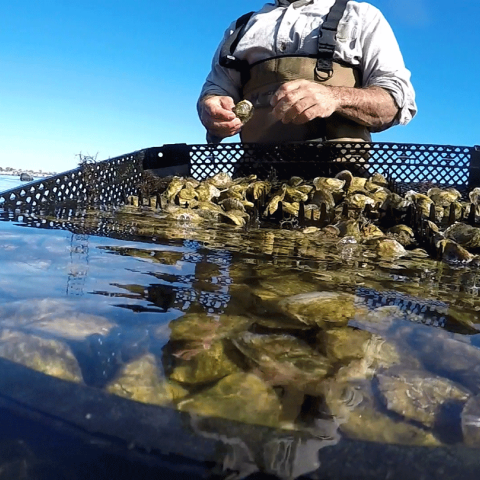The decline of natural oyster reefs in Rhode Island isn’t just bad news for shellfish lovers. Oysters provide ecological benefits, keeping our waters clean. NRCS is working with Ocean State oyster growers to help restore oyster reefs.
Background

Oyster beds were once plentiful throughout Rhode Island’s coastal waters and provided the foundation for the Ocean State’s productive and diverse marine and estuarine fish and wildlife species.
Healthy oyster beds provide many ecosystem benefits, including a biodiverse ecosystem for fish, crabs, mussels, barnacles, and other reef dwellers. Oysters are a high protein food source for migratory shorebirds and other marine organisms. The water filtering capacity of oyster beds improves water quality and clarity.
However, declining oyster habitat has led to a significant loss of ecosystem services and oyster harvest yields.
To reverse the effects of overfishing and habitat change, NRCS is working with the Rhode Island Department of Environmental Management (RIDEM) to restore oyster reefs in protected water bodies as part of the Rhode Island Oyster Restoration Initiative.
Restoring Oyster Reefs

RIDEM and NRCS have been partnering to restore oyster habitat in the Ocean State since 2008. NRCS provides financial assistance through the Environmental Quality Incentives Program (EQIP) for oyster growers to produce spat-on-shell (oyster larvae attached to empty shells) that is deployed over man-made reefs built from clean shell, called cultch.
Phase I: 2008-2011 – 117 oyster reefs created across 7 waterbodies.
Phase II: 2015-2024 – 306 oyster reefs created across 8 waterbodies, to date.
The EQIP Oyster Restoration Initiative in Rhode Island has several phases, including setting oyster larvae at the hatchery, spat-on-shell grow-out on a participants’ lease, oyster deployment at the restoration site, and several years of monitoring the constructed oyster reefs.
Oyster Conservation Practice Scenarios

Creation of Oyster Reef – Cultch
- Reefs are created by using clean cultch bought from local shellfish processing plants or recycled by growers as part of their farm activities.
- Typical site is habitat limited but has the ability to re-seed.
- Juvenile oysters recruit onto the cultch reefs.
Creation of Oyster Reef – Live Oyster
- Reefs are created by placing 250,000 spat-on-shell on top of a reef base built of clean cultch. Goal: 1 million oysters deployed by end of contract.
- Overall goal size is an average of 1 inch.

Creation of Oyster Reef – Live Oyster Large spat-on-shell OR Single Live Oyster
- Reefs are created by placing 200,000 spat-on-shell on top of a reef base built of clean cultch. Goal: 800,000 oysters deployed by end of contract.
- Overall goal size 3.5 inches for singles OR an average of 2 inches for spat-on-shell.
- This scenario is used to deploy single live oysters.
Oyster Reef Monitoring
- Growers hire monitoring contractors to complete disease testing and reef monitoring over four consecutive years.
EQIP Requirements
- Applicant Eligibility: Applicants must hold an active aquaculture production lease in RI.
- Operation: Restoration leases must be in the same bio-security zone.
- Land Eligibility: Written assent/lease and permission to install a practice from RIDEM.
- Restoration Leases: Shown in the USDA Farm Service Agency (FSA) Producer Farm Data Report as “operators or other tenants” on land owned by the State of Rhode Island.
- Practices must be on “submerged land.”
Project Partners
Additional Information
Environmental Quality Incentives Program - Rhode Island
The Environmental Quality Incentives Program (EQIP) provides financial and technical assistance to Rhode Island agricultural producers and non-industrial forest managers to address natural resource concerns in the Ocean State.
Learn MoreHistorically Underserved Farmers and Ranchers
The Agriculture Improvement Act of 2018 (2018 Farm Bill) includes provisions that address the unique circumstances and concerns of socially disadvantaged, beginning, limited resource, and veteran farmers and ranchers (“historically underserved producers”).
Learn More


